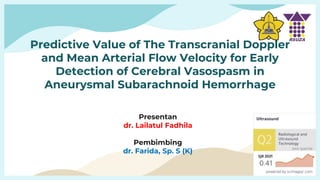
Journal Reading TCD.pptx
- 1. Predictive Value of The Transcranial Doppler and Mean Arterial Flow Velocity for Early Detection of Cerebral Vasospasm in Aneurysmal Subarachnoid Hemorrhage Presentan dr. Lailatul Fadhila Pembimbing dr. Farida, Sp. S (K)
- 3. Introduction o Aneurysmal subarachnoid hemorrhage (aSAH) carries a risk for cerebral vasospasm (CV), which causes reduced cerebral blood flow and delayed ischemic injury. o Around 5.5 per 100,000 persons/year experience aSAH. 20% to 30% of patients with aSAH develop delayed cerebral ischemia (DCI) caused by CV. o CV is one of the main causes of poor outcome and prognosis for aSAH. o CV is characterized by narrowing of a cerebral blood vessel significant to cause a decrease in the distal blood flow. o Approximately 70% of aSAH patients show angiographic vasospasm.
- 4. Introduction Standard tests used to determine the source of bleeding and diagnose CV include CTA or DSA. but cannot be readily performed at the bedside and expose to radiation. Transcranial Doppler (TCD) is a noninvasive tool for assessment of the cerebral blood vessel and predict CV. TCD is inexpensive, repeatable, and allows continuous bedside monitoring of cerebral blood flow velocity (CBFV) Ability TCD to detect the cutoff values of the mean flow velocity to predict CV has not been fully assessed. This study aimed to to determine the cut-off values that predict the development of CV. 01 02 03
- 5. Patients and Methods 1 2 3 Study sample • Prospective study on 45 patients aSAH in department neuropsychiatry, Mataria Teaching Hospital, Cairo, Egypt. • 1 year period initiated on 1 January 2018. • aSAH divided into groups: 26 cases with vasospasm and 14 cases without vasospasm. Inclusion criteria • Adult patient (30-65 years old), both sexes, diagnosed spontaneous aSAH by noncontrast brain CT scan at the onset and confirmed by CT angiography within 72h onset Exclusion criteria • Previous history of disabling brain injuries causing focal neurological sign • A poor temporal TCD window • Decompensated systemic illness • Deep coma (GCS<6)
- 7. Clinical Assessment and Radiological Diagnosis of SAH 1. Full history including factors that have an impact on vasospasm such as the age, sex and history of hypertension, diabetes, dyslipidemia, smoking 2. General clinical examination (blood pressure and full neurological examination) 4. Initial laboratory investigations 3. Admission Glasgow Coma Scale (GCS) score and Hunt–Hess scale 5. SAH was diagnosed on admission by noncontrast brain CT scan, within 24 h the patients had cerebral artery CT angiography and DSA
- 8. Clinical and Radiological Scales for Assessment of SAH
- 9. Monitoring for Detection of Vasospasm TCD was performed using a DWL-EZ-Dop unit, use low frequency 2 MHz for measurement MFV in the middle, anterior, and posterior cerebral artery MFV is calculated by (systolic+diastolic) /3 + diastolic velocities. Follow up TCD were done on the 1st, 3rd , 5th, 7th. and 10th This study compares: • Full TCD examination includes bilateral evaluation of cerebral vessels and usage of the four cranial insonation windows. • The transtemporal technique can determine the flow signals from the MCA, ACA, and PCA. • During TCD examination: Follow the course of blood flow in each major branch, identify and store spectral waveforms at a minimum of two key points per artery. • CT brain and/or MRI brain was performed in patients with suspected vasospasm to detect vasospasm- associated DCI
- 10. Statistical Analysis Analysis of data by SPSS version 22. Statisticsl analysis was performed using X2 and Fisher extract. P<0,05 were significant. Pearson correlation was used to estimate relationship between TCD findings and vasospasm. Odd ratio (OR) was calculated and 95% confidence interval (CI) was estimated. ROC curve was performed to determine the cut off points for MFV.
- 11. Discussion • This study showed TCD was capable of prediction of CV, made a contribution to the diagnosis of vasospasm in 26 (65%) patients. • The evaluation of cerebrovascular hemodynamics mostly depends on the measurement of CBFV, but these estimates may not fully explain changes in cerebrovascular properties. • The alterations in end-tidal PCO2 have been used to further describe cerebral hemodynamic alterations. • DM increases the risk of vasospasm following aSAH independent of glycemic control. • Systolic and diastolic blood pressures were significantly higher in the vasospasm groups. History of hypertension was associated with radiological vasospasm, symptomatic vasospasm, and cerebral infarction. • Higher admission GCS score was significantly associated with vasospasm. • CV following aSAH is more prevalent in patients with higher HHS, indicates an excessive amount of blood in the subarachnoid space.
- 12. Discussion Association between TCD findings and vasospasm • In TCD left side, correlation only the 10th day ACA, 7th day MCA, and 3rd, 5th, and 7th day PCA readings significantly • In TCD right side, only MCA on the 10th day, and PCA on the 3rd day readings significantly • Wozniak et al. reported that patients who developed vasospasm had MFV >120 cm/s in MCA, MFV > 90 cm/s in ACA, >60 cm/s in PCA.
- 13. Discussion (a) The average MFVs of the cerebral arteries measured within the first 10 days of aSAH in patients with vasospasm and aSAH patients without vasospasm (b) Receiver Operating Characteristic (ROC) curve for prediction of CV according to MFV in cerebral arteries in aSAH
- 14. Discussion Prediction of the development of CV and MFV cut-off points within the first 10 days after aSAH
- 15. Conclusions • TCD is a useful tool in early detection, monitoring, and prediction of post subarachnoid vasospasm • Subsequently may become a regularly employed tool in neurocritical care and perioperative settings • Facilitating early therapeutic intervention before irreversible ischemic neurological deficits occur
- 16. CREDITS: This presentation template was created by Slidesgo, and includes icons by Flaticon, and infographics & images by Freepik Thank you
Editor's Notes
- bhg